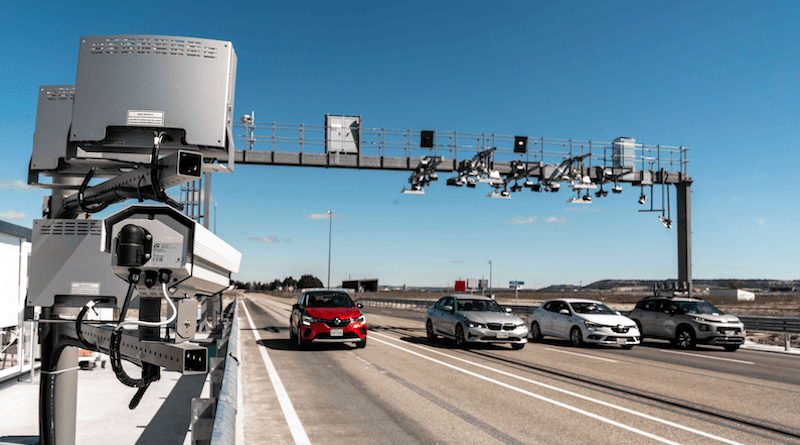Indra To Implement Traffic Management Platform For Connected Highways Using Data From Vehicles And Advanced Sensors
Indra, a leading global technological engineering company for the mobility, aerospace and defense sectors, is working on the development of a pioneering traffic information platform with Cintra, a global mobility solutions company. Together, the companies are providing next generation solutions that will enhance motorist safety by providing relevant information, in real time, and with unprecedented accuracy, Indra said Wednesday.
CRIS (Central Road Information System) can be integrated with the management systems of all highways. The CRIS platform automatically recommends information suitable for sharing with connected and traditional offline vehicles to operators in real time through variable messaging panels. It is a cloud solution that’s applicable to multiple highways thanks to its flexibility and the use of artificial intelligence and edge computing. The system integrates data from all types of sensors from traditional radar and traffic meters to advanced 3D LIDAR sensors and connected vehicles which, themselves, will also act as sensors to identify the highway’s status.
The platform’s real-time data processing capacity is extremely high. It also uses Cellular Vehicle-to-Everything (C-V2X), the latest and most secure communications standard, and has advanced design-based cybersecurity capabilities endorsed by certifications that are updated on a weekly basis to ensure the completeness of the data and to prevent confusing or false information from being sent to connected vehicles.
“The goal of CRIS is to improve safety on highways of the future with high-precision information,” said Manuel López Villena, Infrastructure and Road Traffic Global Director of Indra’s Mobility Business. “The information makes it possible to identify and address any incident with a minimal margin of error. Examples are a person on the road or oncoming vehicles that are going the wrong direction. Having this information helps the driver assess the situation and make the most appropriate decision.”
CRIS initially includes nine easily configurable and expandable services that can be adjusted according to needs: warnings of road works, incidents on the road, approaching emergency vehicles, detection of oncoming vehicles, vehicles stopped on the road, backed-up and slow traffic, pedestrians on the road, nearby circulation of maintenance vehicles and adverse weather conditions.
The Initial Deployment, in the United States
The Cintra-developed I-66 Outside the Beltway project near Washington, DC, will be the setting for the deployment of this scalable and flexible cloud platform. It will have a future processing capacity of ten messages per vehicle per second, for traffic estimated at more than 200,000 vehicles per day.
The I-66 traffic management center will receive CRIS data in real time. This will include road safety messages suitable for sending to road users, thus improving traffic safety and flow.
Indra is currently implementing an advanced managed lanes toll system in this infrastructure to facilitate dynamic pricing under a contract that includes communication systems for connected cars. Going forward, the deployment of CRIS will complement this project, making it much more ambitious with the inclusion of comprehensive coverage of the highway with C-V2X communications equipment. 3D LIDAR devices, comprising advanced sensors with edge computing capabilities thanks to Artificial Intelligence algorithms, will also be installed in highway exit areas to monitor and detect incidents with extremely high accuracy (pedestrians, oncoming vehicles, etc.).
In addition, Indra will equip the highway concession holder’s vehicles with OBU (On Board Unit) equipment so that they will be the first to be connected and send and receive information to and from the platform.
Leading the Way in Connected Vehicles
“Indra has been committed to connected car for over ten years, contributing to the creation of standards and technologies that are making it a reality in RDI and proprietary development projects”, López Villena points out.
Indra carried out the first autonomous driving tests on roads in Madrid, Lisbon and Paris in the AUTOCITS project and, thanks to the experience and knowledge it acquired, positioned itself at the forefront of the market for services for autonomous and/or connected vehicles. As partner of the Spanish national consortium of the European C-ROADS Spain project along with Ferrovial, Indra continued gaining knowledge on deploying and testing services for autonomous and connected vehicles. Indra has also helped increase the cybersecurity of autonomous and connected vehicles through the SECREDAS and SCOTT projects.
Indra currently heads the Mobility 2030 project to promote new smart, automated and sustainable mobility on Spanish roads, overcoming the current technological limitations for the massive deployment of electric, connected and autonomous vehicles on roads and facilitating their integration into the new paradigm of Mobility as a Service. It also participates in the SHOW autonomous driving project, coordinated by the UITP (International Association of Public Transport), and in the R3CAV project, led by Renault, in which Indra contributes its technology to enable high levels of automated driving (Level 4), improve bus management, safety and passenger service, using 5G technology.

